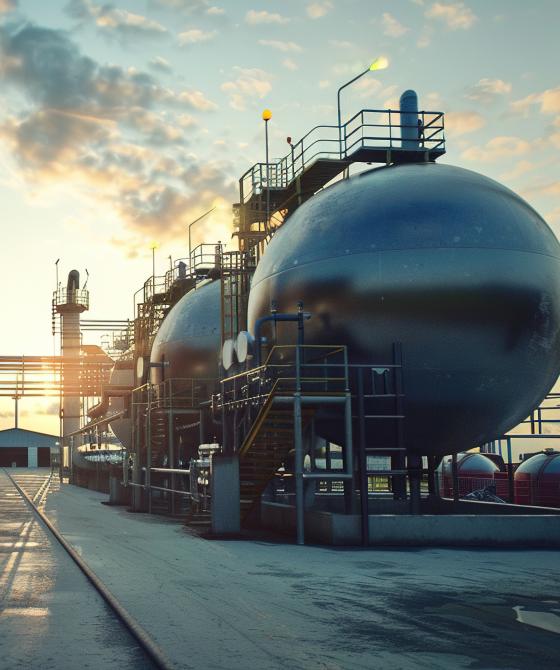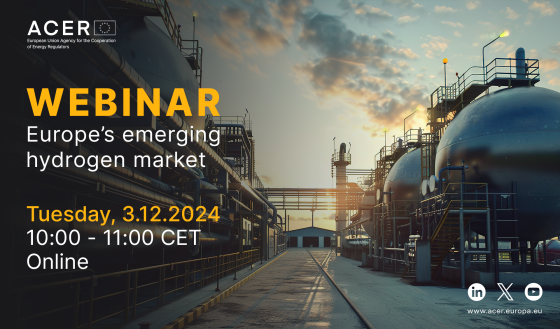European hydrogen markets
2024 Market Monitoring Report
This report marks the start of ACER’s work in monitoring the emerging European hydrogen market (as mandated by the Hydrogen and Gas Decarbonisation Package).
This first hydrogen Market Monitoring Report (MMR), covering 2023 and first half of 2024, sheds light on the main regulatory challenges of the hydrogen markets at EU and national level. It addresses issues such as the repurposing of gas networks and the need for greater coordination by hydrogen, natural gas and electricity network operators.
What market trends did ACER monitoring find?
- Current levels and trends of hydrogen demand mean the EU is likely to miss its 2030 strategic goal of 20 Mt renewable hydrogen consumption:
- Current hydrogen consumption at EU level is 7.2 Mt (99.7% of it produced from fossil fuels).
- EU renewable energy and decarbonisation targets can increase demand for renewable and low-carbon hydrogen by 2030, but so far uptake has been slow.
- Slow electrolysers rollout means the EU is likely to miss its renewable hydrogen production target:
- Total installed capacity of electrolysers in Europe in 2023 was 216 MW.
- Another 1.8 GW of projects expected to become operational by end-2026.
- Around 70 GW of projects announced to be operational by 2030, but few are advanced.
- Overall planned electrolyser capacity is significantly less than the 100+ GW needed to reach EU’s 10 Mt renewable hydrogen production target by 2030.
- High costs prevent renewable hydrogen uptake:
- Renewable hydrogen produced via electrolysis is 3 to 4 times more expensive than hydrogen produced from natural gas, discouraging early offtake.
- Significant electrolysers scale-up and renewable electricity cost reductions are necessary to reduce renewable hydrogen production costs.
- Significant infrastructure plans face uncertainties in implementation:
- 42,000 km of hydrogen pipelines, numerous storage projects and terminals are planned for the next decade, but only 1% has reached final investment decision, as future hydrogen demand uncertainties pose significant challenges to project promoters.
- Integrated planning by (gas, electricity and hydrogen) network operators is needed to ensure grid development at sufficient pace and to optimally locate electrolysers.
- Supporting initiatives to close investment gaps:
- A lot of EU-wide and national support schemes are set to bridge the investment gap, but it can be challenging for project investors to navigate them.
- European Hydrogen Bank’s (EHB) November 2023 auctions resulted in low premiums, revealing cases of low renewable hydrogen production costs and some off-takers’ willingness to pay within the cost range.
- Cost uncertainties still pose risks for early investors, highlighting the need for clearer cost information to increase demand for hydrogen.
What are ACER’s key recommendations?
- Quickly transpose the hydrogen and decarbonised gas package into national legislation and proceed with its implementation. Member States need to develop their national hydrogen markets in line with the EU framework to enable infrastructure development and avoid fragmentation.
- Speed up electrolysers deployment and decarbonisation of electricity sector to increase renewable hydrogen competitiveness. Capital expenditures and electricity are the primary cost drivers for renewable hydrogen. Scaling up global electrolyser production and access to cheap renewables is key to lower the cost of renewable hydrogen.
- Improve forecasting and accelerate integrated planning to identify realistic hydrogen infrastructure needs, avoiding overinvestments and reducing cost related to under-recovery risks.
- When future demand is highly uncertain, consider incremental infrastructure development based on market needs (to avoid building too much network too fast and stranded assets).
- Consider carefully the repurposing of gas networks for hydrogen to minimise costs, while not overlooking the potential impacts on the broader gas sector (including security of gas supplies).
- Address future demand risk in financing hydrogen networks. Properly identify different risks associated with uncertain future hydrogen demand. Allocating these risks among stakeholders (considering also cross-border implications) is key to enable hydrogen infrastructure investments.
- Provide market certainty over the role of non-renewable, low-carbon hydrogen. To reduce hydrogen uptake costs, some stakeholders advocate to use hydrogen produced from natural gas with carbon capture in the short/mid-term. Clarity on the uptake of non-renewable hydrogen should be provided by the European Commission and Member States.
European hydrogen markets

Highlights
Report
Europe's Hydrogen and Gas Decarbonisation legislation (2024) tasks ACER with monitoring the emerging hydrogen market.
ACER's first hydrogen monitoring report highlights that, despite ambitious EU strategies, hydrogen projects face risks from uncertainties of future hydrogen demand and high costs.
Infographic
Interested in the main highlights of the report?
Webinar
ACER will hold a webinar to present the main findings and recommendations of this report.
When?
Tuesday, 3 December 2024 at 10:00 CEST.

Additional information
- Access the underlying datasets



